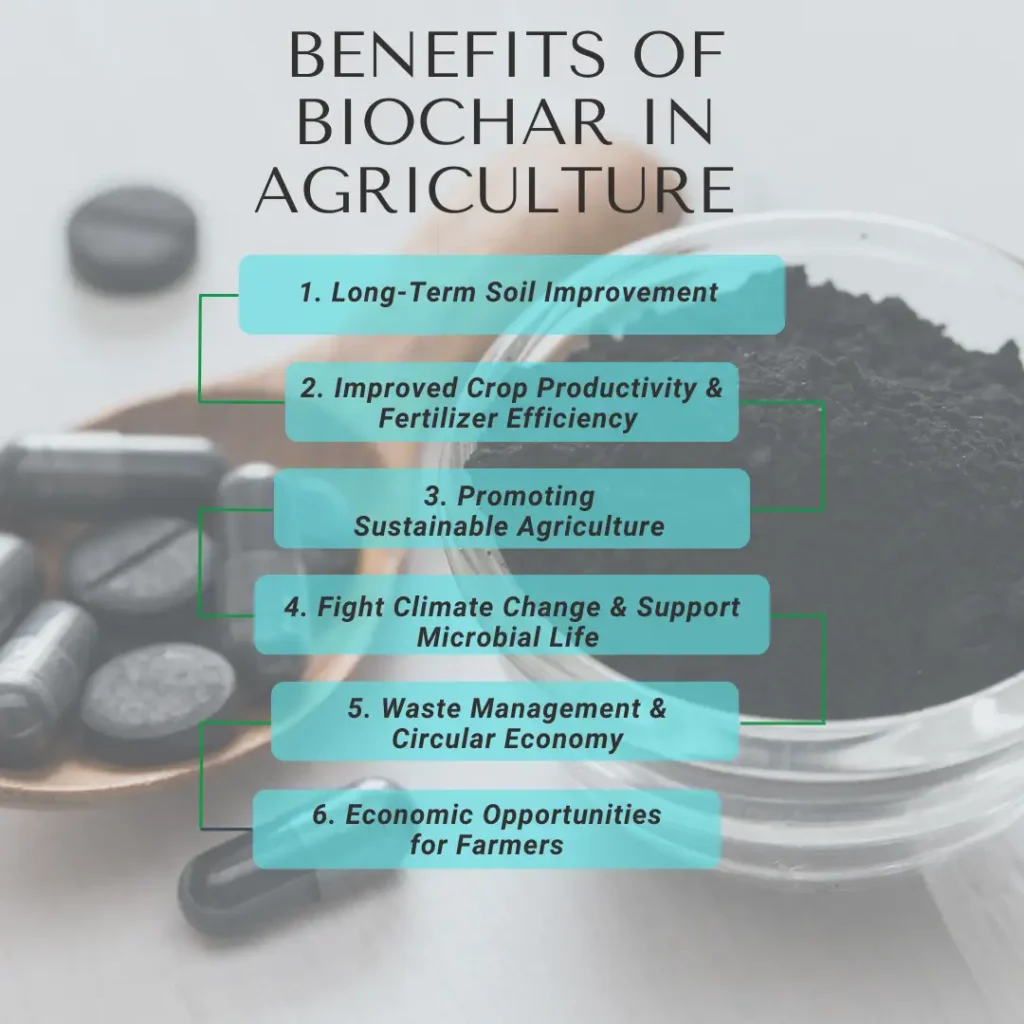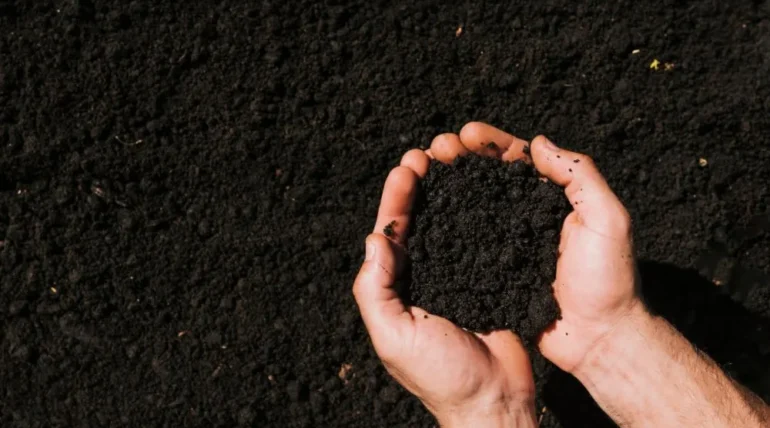Biochar, a carbon-rich material created through pyrolysis, offers agricultural benefits while supporting sustainable communities. And while the biochar market is gaining popularity, it’s far from a new concept.
Biochar has been used by humans in traditional agricultural practices in the Amazon Basin of South America for more than 2,500 years. This demonstrates how the use of biochar in agriculture helps preserve resources for future generations, making it a key strategy in sustainable farming practices.
Keep reading to explore how biochar is used in agriculture and farming, its benefits, challenges, and more.
Key Takeaways
- There are various ways to use biochar in agriculture, such as seed coating, fertilizer blending, and broadcasting, with proper application depending on soil type, crop requirements, and the intended benefits.
- Biochar helps improve water retention, foster nutrient absorption, and promote microbial activity, all of which support long-term soil health.
- By turning waste into biochar, farmers can divert waste from landfills, reduce greenhouse gas emissions, and preserve valuable nutrients, thereby supporting a circular economy.
- Biochar production allows farmers to create new revenue streams, cut fertilizer costs, and boost crop yields, enhancing both profitability and long-term sustainability.
How Biochar Is Made and Applied
So, how is biochar used in agriculture and farming?
Let’s look at how biochar is produced and three key methods farmers can use to apply it.
How Biochar Is Produced
There are several methods for producing biochar, each yielding unique properties suited to specific soils and crops. The main methods include:
- Pyrolysis: Pyrolysis is the process of heating an organic material in the absence of oxygen, resulting in bio-oil, biochar, and syngas. During this process, the temperature plays a key role in determining the characteristics of biochar. For example, a study on rice straw and husk biochar found that higher pyrolysis temperatures reduced biochar yield but increased carbon content, pH, and electrical conductivity.
- Gasification: Gasification is a process that converts carbonaceous materials into syngas through high-temperature partial oxidation. These systems yield smaller amounts of biochar in directly heated reaction vessels with introduced air; however, the less oxygen present, the greater the biochar production. As with other processes, the choice of feedstock also influences the properties of the biochar. For instance, it has been reported that biochar obtained by gasifying coconut residues contains a significant amount of carbon, minimal ash, and a vast surface area.
- Hydrothermal carbonization: Hydrothermal carbonization is a thermochemical process that converts wet biomass into a carbonized structure by applying controlled heat in water within a low-energy, closed vessel system. This process, often called wet pyrolysis, converts raw biomass into hydrochar—a coal-like product with high carbon content and calorific value.
The Use & Application of Biochar in Farming & Agriculture
There are various ways to use biochar in agriculture, with proper application varying depending on soil type, crop requirements, and the intended benefits.
That said, three common methods of biochar application include:
- Seed coating: Seed coating consists of covering seeds with low amounts of exogenous materials. While various materials can be used, incorporating biochar into seed coating promotes efficient waste utilization and supports a circular agricultural economy. A previous patent on biochar-based seed coating described a method where seeds are first mixed with starch or another suitable binder in a rotary tumbler, and then biochar is added to the mixture until the coating reaches the desired thickness.
- Fertilizer blending: Fertilizer blending is the process of mixing two or more different materials together to create a custom fertilizer blend with a specific nutrient composition. For instance, professionals interested in the use of biochar in farming can mix biochar with other soil amendments such as manure, compost, or lime before soil application.
- Broadcasting: Broadcasting involves spreading fertilizers uniformly over the soil surface. This biochar application to soil is commonly used in large-scale crop production, using equipment such as spreaders for even distribution.
For a deeper understanding, the video below explores on-farm biochar production and its practical application in Brazil.

The Benefits of Biochar in Agriculture
Biochar farming has an array of environmental and economic benefits, including:

1. Long-Term Soil Improvement
Biochar helps improve water retention, foster nutrient absorption, and promote microbial activity, all of which support long-term soil health.
A study on the long-term effects of biochar amendment on calcareous soils provides valuable insight into this, stating that, “Biochar amendment was shown to cause a long-term benefit on crop productivity in calcareous soil. A persistent crop yield increase was observed with biochar amendment, although this varied with different soil conditions and biochar types. Soil fertility was consistently improved under biochar treatment, with significant increases in the SOC soil’s available nutrient content. The carbon, nitrogen, and phosphorus cycling-related extracellular enzyme activity was increased for five or six years following one-time biochar application.”
2. Improved Crop Productivity & Fertilizer Efficiency
Did you know that biochar can increase crop productivity?
Its unique characteristics, such as high surface area and pore volume, make it highly valuable in agriculture by enhancing crop production, soil condition, nutrient uptake, and carbon sequestration. This reduces the need for chemical fertilizers, thereby promoting sustainable agricultural practices.
3. Promoting Sustainable Agriculture
Biochar has gained significant attention for its potential in sustainable agriculture, environmental management, and climate change mitigation. That said, the role of biochar in sustainable agriculture should not be underestimated, as it helps mitigate climate change, enhance soil fertility, improve crop yield, and support effective waste management.
4. Fight Climate Change and Support Microbial Life
When added to soil, biochar captures and stores carbon that would otherwise oxidize and return to the atmosphere as CO₂. In other words, biochar acts as a carbon sink, contributing to long-term carbon sequestration and mitigating climate change impacts.
At the same time, biochar’s high surface area and porous structure provide an ideal habitat for beneficial soil microorganisms, fostering microbial activity that further enhances soil fertility and nutrient cycling.
5. Waste Management and Circular Economy
One of the benefits of biochar to the environment is that it supports sustainable farm waste management. By turning waste into biochar, farmers can divert waste from landfills, reduce greenhouse gas emissions, and preserve valuable nutrients, thereby supporting a circular economy.
6. Economic Opportunities for Farmers
Biochar production creates new revenue streams for farmers by transforming agricultural waste into a valuable product. By selling biochar as a soil amendment, farmers can diversify their income beyond traditional crops.
In addition, farmers who use biochar in their fields can reduce costs associated with chemical fertilizers while increasing crop yields, both of which enhance profitability and long-term sustainability.
Challenges, Limitations & Key Considerations for Using Biochar in Agriculture and Farming
While there are many benefits of biochar, there are also challenges and limitations that companies should be aware of.
1. High Production and Application Costs
One of the major challenges of biochar adoption is its high production and application costs. The expenses associated with feedstock collection, pyrolysis technology, and large-scale field application often make biochar less competitive than conventional soil amendments.
When you work with a biochar company like Shapiro, however, you gain access to specialized expertise, efficient production methods, and tailored application strategies that help reduce costs.
2. Potential Changes to Soil pH and Salinity
Another challenge is the potential impact of biochar on soil pH and salinity. Depending on the feedstock and production conditions, biochar can alter soil chemistry in ways that may not always be favorable for certain crops or soil types.
This variability makes it essential to carefully evaluate biochar before widespread application to avoid unintended consequences.
3. Overapplication and Diminishing Returns
Over-application of biochar can elevate soil pH beyond the ideal range for crops, impacting nutrient availability and potentially reducing soil fertility and crop yields. That said, the lack of clear, locally relevant guidance on how to use biochar effectively can be detrimental and costly for farmers, particularly when implemented on a large scale.
4. Logistical Challenges for Large-Scale Use
Applying biochar to large agricultural areas requires significant machinery and careful coordination. Transportation and storage of biochar materials also add to the complexity, often limiting its practicality for widespread adoption.
To ensure that the investment translates into improved ROI, farmers must plan accordingly to manage these logistical demands.
5. Changes to Soil Microbial Communities and Their Abundance
The use of biochar in agriculture may change the activity of beneficial soil microbes and disrupt nutrient cycles, indirectly influencing crop growth and quality. To address this challenge, farmers must carefully match biochar type and application rate with specific soil conditions to minimize negative effects.
How Biochar Supports Shapiro’s Commitment to Sustainable Agriculture
At Shapiro, we’re passionate about reducing the environmental impact of organic waste. As an experienced waste management company, we offer a range of farm and agricultural waste solutions, including solutions for commercial biochar production.
Our team will assist you with feedstock identification, collection and transport, storage, and pre-processing to help you stay compliant and streamline waste management. And since we know every company is different, we tailor our services to your unique needs, helping you achieve your sustainability goals.
Conclusion
Understanding how biochar is used in agriculture and farming helps farmers improve soil health, reduce waste, cut emissions, and adopt more sustainable practices.
Whether you’re interested in biochar production or another food waste recycling approach, our team at Shapiro can guide you through the process with practical solutions that align with your sustainability goals.
Contact us to learn more about waste management services.
FAQs about the Use of Biochar in Farming
While a diverse range of plant species can benefit from biochar, vegetables, flowering plants, and tree crops tend to show the most significant improvements.
Biochar is commonly recommended at no more than 10 tons per acre in field crop production.
Common mistakes include over-application of biochar, failing to select the most suitable feedstock for the crop and soil type, and not applying the right amount at the right time.
Biochar application requires the right source, right place, right rate, and right timing. For practical insights on applying biochar to annual and perennial crops, read this guideline.
Baily Ramsey, an accomplished marketing specialist, brings a unique blend of anthropological insight and marketing finesse to the digital landscape. Specializing in educational content creation, she creates content for various industries, with a particular interest in environmental initiatives.



